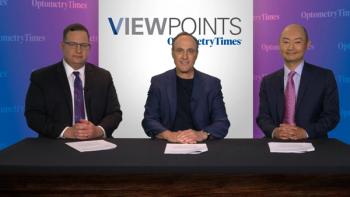
Retinal Monitoring Centers Described
An overview of the services provided by retinal monitoring centers, and insight on their use by optometrists who have begun using remote monitoring in their clinical practices.
Episodes in this series

John Rumpakis, OD, MBA: I’d like to talk about what these retinal monitoring centers or remote monitoring centers are as we get into the next segment of things. They may be a new thing to many people out there. I know that people have read about them and talked about them, but they may not be familiar with what a remote monitoring center is. And they’re not all equal.
If we start to talk about the ones that are involved in the retinal space primarily, when we start to talk about either a visual field test being done or a remote OCT [optical coherence tomography] being done, those types of technologies that are available, a remote monitoring center by definition is what we call an independent diagnostic testing facility [IDTF]. That’s a legal description because that facility performs the test and bills for the test in and of itself. And it only accepts patients referred by an attending physician who is either providing a consultation or treating a patient for a specific medical problem, and those results are specifically used in monitoring that patient.
The most important thing from a payment basis or coding basis, if you will, which we’ll cover later, is that the IDTF is a separate entity, and so there’s no billing of that test by the physicians themselves. That’s a relationship between the remote center, the insurance carrier, and the patient, just the 3 of them. The physician makes the referral, gets the service set up, and then is the beneficiary of getting the remote monitoring. But the IDTF is a separate entity, and we’ll discuss how that’s such an important thing later.
How is your involvement, is your communication good? Have you been happy with how you get communicated with regarding the results, Steve?
Steven Ferrucci, OD, FAAO: Yes. The system works well because the results, like you said, once the doctor prescribes a [remote monitoring] unit for the patient, at that point there’s not much more involvement with the doctor. They prescribe it, the company will call the patient, they’ll send them the unit, they’ll train them on the unit independently, and then they’ll encourage a patient obviously to do it. Then those results will get sent in to the reading center. If there’s a significant change in their metamorphopsia, or looking for macular metamorphopsia, which often is the first indication of conversion from dry to wet, it will send an alert not only to the patient but also to the doctor’s office, instantaneously essentially, that there is a significant change. Then you can call the patient and say, “Hey, Mrs. Jones, I was just alerted that there was a change in your readings, you really need to come in and see me so we can make sure that everything is OK.” It works quite seamlessly, and the doctor involvement after finding the correct patient whom they feel would benefit from it is pretty negligible, quite frankly.
John Rumpakis, OD, MBA: Great. Do you find the patient acceptance of the remote monitoring center good, Jaya?
Jaya Pathapati, OD: Yes, absolutely. It’s peace of mind, and they feel much more comfortable that I’m going to be monitoring them, basically. They’re like, “Doctor, you’re on top of it? I’m not worried.” In the examination room I’ll send a quick note to my technician and she’ll send the email out, and we let them know they’re going to be contacting you directly, and they’ll take care of all the insurance information. I’ve had several patients come back and say, “They keep calling me.” And I say, “Well, you must be not doing your homework, and you’ve got to go use the device. That’s the point of it.” It’s been good. We’ve had a few alerts, I got an alert Saturday evening. We have 3 emails on file for them to send the report if there’s an alert. I called the patient Sunday morning and said, “I need to see you,” and she did convert. She still has great vision, thankfully, because it was caught so early. It was one of the first patients I referred for remote monitoring, and that just blew my mind that we can do this now and help these patients.
Steven Ferrucci, OD, FAAO: Besides being great technology, using vernier acuity and preferential hyperacuity perimetry to find these changes sooner, the other advantage is compliance. If you give a patient a home Amsler grid, we have no idea if they ever look at it. But with these remote monitoring centers, they can see how much the patient is doing it, and if they realize, geez, a week has gone by, 2 weeks have gone by, Mrs. Jones hasn’t done it, they can call the patient. They can say, “Hey, Mrs. Jones, we notice you’re not doing the test. Is there a problem? Do you need us to explain to you again how to do it? Are you having some technical issues?” You have that built-in compliance, which is fantastic, and is what obviously a home Amsler grid lacks 100%.
Transcript edited for clarity.
Newsletter
Want more insights like this? Subscribe to Optometry Times and get clinical pearls and practice tips delivered straight to your inbox.



















































.png)


